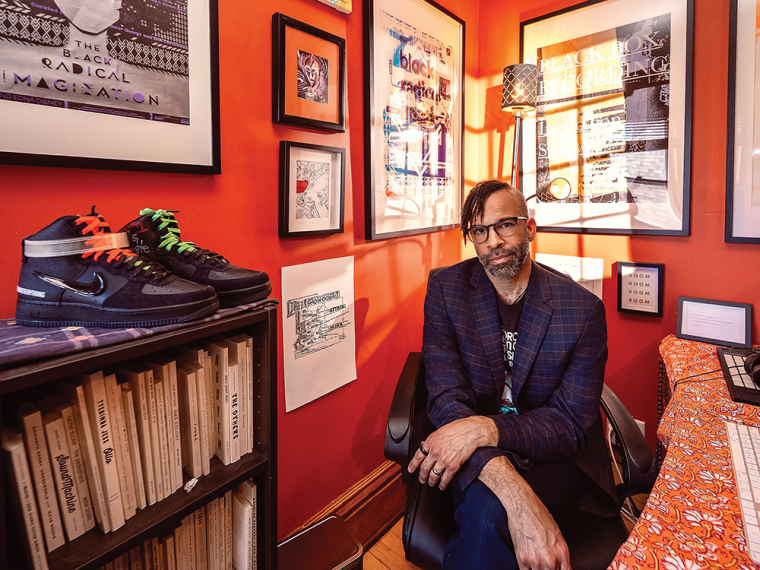Indeed, Kearney is enthusiastic about the power of reference and allusion, even as some critics of poetry have decried it as a kind of inside baseball that keeps readers from fully understanding the many meanings present in a piece. In “Game Over,” a piece that appears in “Over Deluxe AF,” a map of the land north of the Dead Sea (which was formerly part of Jordan and is now the Israeli-occupied West Bank) is overlaid with a snippet of text from Harriet Beecher Stowe’s Uncle Tom’s Cabin. The excerpt is from one of the book’s most iconic scenes, in which a fugitive enslaved woman, Eliza, crosses the Ohio River by jumping between jagged sheets of ice. During our discussion of “Game Over,” Kearney describes his methodology and what he hopes readers can appreciate about the allusive aspects of his work.

Douglas Kearney in his home office. (Credit: Krizia Studios)
“I was really interested in the preposition over and how [it] operates in Black systems of knowledge and thinking. For me, ‘going over Jordan’ is to die. But ‘getting over’ can [also] mean to transcend, to live beyond. People oftentimes will fuss about allusion. They’re like, ‘Why you got stuff hidden? I shouldn’t have to leave this book to find out what it means.’ But if I’m doing it well, there’s enough there that you go, ‘Oh, this language makes sense here.’ You might not know what it’s from, but it’s doing something associatively. It’s not about getting it. It is about this moment of recognition. That’s what quotation does: It is drawing something from this other source into your work. If you have a quote from the Bible before a poem, you’re saying something, not only about yourself and what you’ve read—you’re saying that this poem is in dialogue with something that large. And maybe the point is to make the poem larger, or to make the thing smaller.”
As a reader who shares with Kearney a similar childhood, reared in evangelical Christian spaces, I recognized biblical allusions in I Imagine I Been Science Fiction Always, particularly in “Dark Matter Armory Flex,” which is perhaps the book’s most visually provocative sequence. In it Kearney creates nineteen figures that comprise a complete suit of armor from crown to foot, giving the items names such as “‘Ease My Mind Shell’ Field Holler Helmet,” “‘Clenching Fists Memory Circuits’ Pattin’ Juba Gauntlets,” and “‘Watch Your Step Don’t Fail’ Anthem Sabaton.” But the figures that follow are only anatomical in the most theoretical sense. Musical bars, diagrams, leaflets, and product labels vie for space alongside comic sequences and more American flags. It is what Kearney calls a “performance typography.” When I explain to him that the itemization of protective garments feels reminiscent of the apostle Paul’s admonition in Ephesians 6:11 to “put on the whole armor of God,” Kearney nods knowingly. He is demure about the religious aspects of his work but admits that it is a through-line in many of his books, and editor friends have often asked when he will compile his religious poems into a single volume.
When I ask how readers should read these visually complex poems on the page, he is more forthcoming.
“I think about these kinds of poems like sample-based hip-hop. Producers and DJs make something they want other people to hear. But they’re also counting on people hearing it in different ways. They’re thinking about how the MC will hear it, how they are going to flow to it. They’re thinking about how the people in the club will hear it, or [how people wearing] headphones will hear it, but they’re also thinking about how other beat makers will hear it. So with these [new] poems, one of the things I had to think about was, ‘Okay, if I want people to be able to truly read wherever and however much—they might just look at one corner and be done—how can I fractally create language that does similar things across this composition,’ enough that, if you just read this one, you could be like, ‘Okay, that’s a thought. That’s a thing. I got that.’ For me, a lot of the poems in the collection accomplish this. One of my favorite poems in the collection, however, works against that. It’s one of the last ones I did, ‘“Watch Your Step Don’t Fail” Anthem Sabaton’ [Fig. 17 in the ‘Dark Matter Armory Flex’ series]. By putting that in a sequential art-comic approach [comic book panels and arrows guiding the reader across the page], I’m essentially ordering it. I’m saying, ‘You start up here and you’re doing that.’ And so, even though I visually like that poem, it is one of the poems that does a different thing than what I was thinking all the poems could do.”
Kearney’s description of “Watch Your Step” and his prescription for how it can be read is perhaps a reading strategy for the entirety of I Imagine I Been Science Fiction Always. This is a trickster of a book, one that requires its reader to pay close attention to what is overt as well as what lurks beneath—in other words, to listen to “that loud-assed colored silence” and to watch one’s “shadow, yo(u)” (which happen to be the titles of the fifth and sixth sequences of the book). I Imagine I Been Science Fiction Always is both weighty and whimsical. It plays with and on words, and as Kearney points out, it challenges its own methodology in a way that speaks to the precarious nature of Black life in America, this palimpsest of physical, economic, and existential vulnerability that many Black artists have grappled with—and managed to create beauty from—since birth.
![]()
Kearney, who was born in Brooklyn, New York, in 1974 and raised in Altadena, California, a historically Black community that was devastated by the wildfires that tore through it in January, posits that his entire existence has been defined by what he calls “double dreaming, double imagining.” This DuBoisian concept informs the book right down to its title. Growing up in Altadena offered Kearney unique training as an artist of contrasting mediums and many identities. During the 1970s and 1980s it wasn’t uncommon to see riders on horseback passing liquor stores with lowriders out front on Altadena Drive. Nestled in the foothills of the San Gabriel mountains, the city has a radio station whose signals would often cross, and one could go from listening to the news to hearing strains of doo-wop or snippets of Spanish from Raza Radio, an L.A.-based station that catered to the language and music of the city’s Mexican American population. At the same time, fragile racial tensions bubbled just beneath the surface, even in the most sacred spaces. Kearney vividly recalls a white fellow parishioner’s reaction to the verdict in the 1992 Rodney King trial, when four LAPD officers were acquitted of severely beating a Black man during a traffic stop.
“I remember him looking at me and smirking,” says Kearney. “And I was like, ‘This is where I come twice a week to worship. This is where I come to bring something out of myself that is transformational.’ These were spaces where I found lots of love. I found lots of support, [but] I was also aware of how that might be contingent and how people sometimes demonstrated that, just for this minute, things might be cool, but always remember that they don’t have to stay that way.”
This lesson—that there are multiple ways of seeing and being seen—resonates with the poet to this day. It also describes how I Imagine I Been Science Fiction Always earned its title in a process Kearney explains near the end of our call. In Pattern, Constraint, and Sound, a version of a course he first taught at the California Institute of the Arts and now teaches at the University of Minnesota Twin Cities, every student is asked to invent two poetic forms, and everyone in the class—including Kearney—must write a poem in one of those forms. One CalArts student, Teo Rivera-Dundas, invented the robot-voice poem, in which drafts of a piece are repeatedly read aloud to a randomizer, a device that randomly selects and reorders text.
“In the writing of the [title] poem, I landed on this phrase, ‘I guess I imagine I’ve been science fiction always,’” says Kearney. “Now that particular bit of language was referencing the idea of the Black subject as a kind of a machine, a kind of automaton. It goes back to [my second collection] The Black Automaton, [where] I think about this space of two levels of imagination: the imagination of the self, the self-conception, then a category that’s outside of the self being imposed. But what is the self in that construction? What is it like? If you have been science fiction always, are you agreeing? What part of it do I feel? What parts of alterity am I claiming?”
These are perhaps the perpetual questions of Black art—questions Kearney has posed in his poetry time and time again. While this new collection is radically different from his previous one, it is part of an artistic trajectory that, for Kearney, is ever transforming. Kearney’s poetry continues to occupy multiple realms of past and present, untouched space and palimpsest, physical location and collective memory. Perhaps it was destined to do so from the poet’s earliest days.
“I Imagine I Been Science Fiction Always came from that deep, dark, and now, I suppose, digital well of meaning and signification,” says Kearney. After a brief pause, he lowers his voice. “And if this is how we would define science fiction, then I don’t think I ever had a chance to be something else.”
Destiny O. Birdsong is the author of the poetry collection Negotiations (Tin House, 2020) and the triptych novel Nobody’s Magic (Grand Central, 2022). She is a contributing editor of Poets & Writers Magazine.








